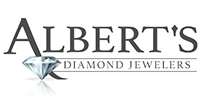GEMSTONES & BIRTHSTONES
BIRTHSTONES
January: Garnet
Garnets are gemstones that are usually shades of red, but span the color spectrum. They may be opaque to transparent and are vitreous to resinous in luster. Red Garnet used for the bead market is often dyed to enhance the color.
February: Amethyst
Amethyst is actually a naturally occurring form of quartz. It is usually found in geodes of volcanic rocks. Amethyst prices vary widely based on color (very dark purple to very pale), clarity (inclusions), and cut/shape.
March: Aquamarine
Most aquamarines are of a very pale light blue and have a few inclusions (other minerals inside the stone which are considered impurities and reduce the gemstone's clarity and sparkle). It is possible to find very large (over 10 carats) aquamarines. The most common cuts for aquamarine are step cuts (“emerald cuts”).
April: Diamond
The birthstone for April is the diamond. One of the most revered gemstones for adornment; diamonds are sought after for their brilliance, scintillation, and light dispersion properties. Diamonds are available in a range of colors, including yellow, red, pink, blue and green. Ranging in intensity from faint to vivid, generally the more intense the color is, the higher the value. Because fancy-color diamonds are very desirable, color is sometimes introduced in a laboratory. These are known as color-treated diamonds.
May: Emerald
Emerald's precious green color is caused by trace amounts of chromium and vanadium. Emerald is most often cut in a rectangular step-cut, which is now popularly known as the emerald cut. Smaller sizes are also found in rounds, ovals, pear shapes and marquise cuts.. Due to their rich color, emeralds are also spectacular when cut in a smooth-domed cabochon cut.
June: Pearl, Alexandrite, Moonstone
June counts three gems as birthstones: Pearl, Alexandrite, and Moonstone.
Pearls have been used as an adornment for hundreds of years. Since ancient times, the pearl has been a symbol of unblemished perfection. It is the oldest-known gem, and for centuries it was considered the most valuable. Pearls are unique as they are the only gems derived from living sea creatures and require no faceting or polishing to reveal their natural beauty.
A relatively modern and rare gem, Alexandrite was first discovered in Russia in 1831 during the reign of its namesake, Czar Alexander II. Its color is a lovely green in both daylight and fluorescent light, and changes color to a purplish red in incandescent light.
The third birthstone for June is the Moonstone. It was given its name by the Roman natural historian Pliny, who wrote that moonstone's appearance altered with the phases of the moon — a belief that held until well after the sixteenth century. A phenomenal gemstone, moonstones show a floating play of light (called adularescence) and sometimes show either a multi-rayed star or a cat's eye. Part of the family of minerals called feldspar, moonstone occurs in many igneous and metamorphic rocks and comes in a variety of colors such as green, blue, peach, and champagne.
July: Ruby
Rubies have been important in many cultures for thousands of years. Ruby is characterized by its vibrant shades of red, excellent luster (facets reflect light almost like a mirror), and hardness (it is difficult to scratch and therefore resilient). Very fine large gemstones of ruby are exceedingly rare.
August: Peridot
Peridot is the gem variety of olivine. It is not exceptionally rare, but large pieces with intense color can command high prices. Peridot's most striking feature is its particular, bright shade of green. Inclusions are also common in peridot, making clear pieces more valuable
September: Sapphire
Sapphires come in every color except for red. (A red sapphire is called a “ruby”) Sapphires are valued for their strong luster (ability to reflect light like a mirror), and hardness: they are the next hardest stones after diamonds. This means they can be worn in rings and bracelets for centuries with a low chance of being scratched
October: Tourmaline and Opal
Tourmaline has become a favorite gemstone among jewelry designers and gem collectors around the world. Since it is available in a wide variety of colors, it is ideally suited to almost anyone's taste. Tourmaline is also known for displaying several colors within the same gemstone. These bi-color or tri-color gems are formed in many combinations, and gemstones with clear color distinctions are highly prized.
The second October birthstone, Opal, derives its name from the Greek Opallos, meaning "to see a change (of color)." Opals range in color from milky white to black with flashes of yellow, orange, green, red, and blue. An opal's beauty is the product of contrast between its color play and its background. Opal is said to be a stone of inspiration, enhancing one's imagination and creativity
November: Topaz and Citrine
November birthstones include Topaz and Citrine.
Topaz is a gemstone available in a variety of colors. Often confused with citrine quartz and smoky quartz, topaz is a separate and unrelated mineral species. The most prized color of topaz is imperial topaz, named after the Russian Czars of the 1800s. It features a magnificent orange body color with pinkish undertones. Topaz also comes in yellow, pink, purple, orange, and various blue tones.
Citrine, the other birthstone for November, is known as the "healing quartz." This golden gemstone is said to support vitality and health while encouraging and guiding hope, energy and warmth within the wearer. Citrine can be found in a variety of shades ranging from pastel yellow to dark brownish orange.
December: Blue Topaz and Tanzanite
December is another month with two birthstones: Blue Topaz and Tanzanite.
Blue Topaz is the hardest of the silicate minerals. While pure Topaz is colorless, minor changes of elements within the stone result in a variety of other colors, such as blue, pale green, red, yellow and pink.
The blue hue is created when Topaz is heated, whether the heat source is natural or engineered by man. The three shades of Blue Topaz are Sky, Swiss and London Blue. The latter is the deepest blue and is often used as a less expensive substitute for Sapphire
Tanzanite is the gem variety of zoisite and its color is always in shades of blue with sometimes violet, grey or greenish hues visible as the gemstone turns (pleochroism). It is unique in the gemstone world because it was discovered quite recently (in 1967). The major known tanzanite deposits are in East Africa and seem to be mostly exhausted. It is a very popular gemstone and fine tanzanite pieces are getting increasingly hard to find.
GEMSTONES
Gemstones have been present in rock formations that have been confirmed to be over 200 million years old. Most are composed of metaphoric rock that crop up beneath young mountain ranges. After millions of years the stones began to dig their way upward toward the earth's surface through the process of erosion. While most precious stones are found in mountainous areas, some have been known to show up in riverbeds.
DESCRIBING GEMSTONES
Specific Gravity: Specific gravity is a measure of how much heavier a mineral is than an equal amount of water.
Hardness: Hardness is the resistance of a mineral to scratching. Geologists use a measurement called Mohs' scale to describe the hardness of a mineral.
Color: Gemstones are described according to their color because it's a useful characteristic. Diamonds are clear, but can be tinted yellow, pink, or even black from the presence of other minerals.

 Request an Appointment
Request an Appointment 

